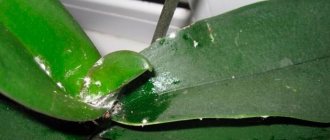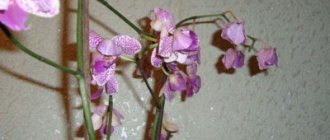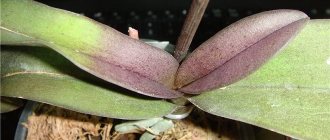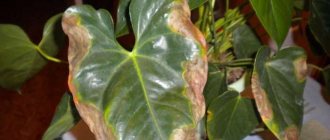In the orchid we look, of course, at beautiful flowers . When we choose it in the store. And it doesn’t matter whether it’s a gift or for your collection.
Below in the article we will tell you in detail about different bugs on an orchid and how to deal with them.
People have been staring at the beauty of orchids for many centuries.
After all, their story is amazing :
- These beautiful plants grow on all continents and in different conditions. Except Antarctica. The number of species alone is amazing - more than 25 thousand;
- Several thousand years ago they were depicted in drawings and given to lovers;
There are many stories about orchids. - They were deified by many peoples. They made potions and various amulets;
- Orchids have been used by many healers to prepare medicines and treat many diseases;
- Vanilla is still made from some species of these plants today. An irreplaceable spice. The Aztecs even used vanilla pods as a means of payment.
Nowadays, orchids are no longer uncommon in ordinary apartments.
In nature, more is known about representatives of mountainous tropical regions with their hot climate and frequent rains. Few people tell what bugs they saw in the habitats of these beauties. Maybe it's not that important.
Orchid growth in nature.
But at home, and even in greenhouses, there are plenty of different bugs. And we need to recognize them . To protect such beautiful flowers.
Appearance and photo
Each type of pest leaves signs of its vital activity, by which the parasite can be identified.
Pests
Thrips
They are very small in size. These are dark-colored bugs up to 2.5 mm in size . When examining them in detail, you can notice two pairs of wings on the back. They usually hide in the substrate, where they are difficult to identify.
Shchitovka
The presence of scale insects is immediately visible - brown or yellowish tubercles appear on clean leaves. The insects have quite “impressive” sizes - adult individuals reach 5 mm in length.
Female parasites are absolutely motionless, while males can fly thanks to their two front wings. The scale insect has a translucent shell covering its body.
Fools
Parasites up to 3 mm. greenish, gray or gray-brown in length . Insects move quite quickly - they can even jump.
Spider mite
It is quite difficult to see a tick with the naked eye, but with the help of a magnifying glass you can see a yellow or red insect in the web. The beetle larvae have the same bright color.
Mealybug
Mealybugs, which are small in size, are not easy to notice . Its presence on the plant is indicated by shaggy white balls. Both adults and their larvae hide under this cover.
An adult insect is pink or white in color, sometimes light brown specimens are found. The size of the bug is up to 5 mm.
Affected leaves and stems
It is not easy to identify parasites on an orchid due to their small size. But thanks to obvious signs of plant damage, the type of insects can be quickly identified and the fight against them can begin.
- If grooves appear on the leaves in the form of streaks, and black dots (insect excrement) are visible everywhere on the plant, then you need to urgently begin exterminating thrips.
- When a spider mite appears, the orchid leaves become covered with black dots, which are the result of punctures by the insect. Subsequently, the leaves lighten and dry out.
- A shaggy white coating on certain areas of orchid leaves is a characteristic sign of the appearance of a mealybug. Parasites feed on flower sap, reducing the ability for photosynthesis and causing disruption of gas exchange processes.
- Brownish tubercles on the leaves and stem of the orchid indicate the appearance of a scale insect, which lives by feeding on the cell sap of the plant. First of all, the scale insect settles on the back side of the leaf, then moving to the root zone, stem, and inflorescences. As the tubercle grows, the processes of photosynthesis in the leaf are disrupted, and parts of the plant begin to die.
This is what the affected leaves look like:
Possible places where pests appear
There are spots on the leaves on the orchid - what to do?
Depending on the parasite, either the roots or the ground part of the flower are damaged.
On orchid leaves
Mealybugs, whiteflies, and spider mites are common on the leaves. When buying an orchid, there is a risk of bringing a plant already infected with a parasite, since the larvae can hide in the axils of the leaves or in the roots.
In the ground
Bulb mites, poura, and springtails reproduce and live in the soil. Also, the substrate for orchids is suitable for the life of ants, woodlice, centipedes, spiders, thrips, etc. It is extremely difficult to detect insects at an early stage. When the first symptoms of damage appear, it is already too late to do anything.
What happens to an orchid when the substrate is infected with parasites?
Why can they grow in the soil, on roots and leaves?
Pests in a flower garden do not appear on their own - infection with parasites occurs for several reasons. These experienced flower growers include:
- systematic overflow;
- low quality substrate;
- infection from other indoor plants;
- purchasing a plant with parasites.
Source of infection
If the plant has not recently been replanted, and new flowers have not appeared in the house, then the cause of the appearance of bugs is faults in care.
Stagnation of water leads to rotting of the bark, which easily infests parasites . In the bark of pine, which gardeners like to use as soil for orchids, various bugs live in natural conditions.
Such a neighborhood is imperceptible for a tree, but for phalaenopsis or dendrobium it can be disastrous. It is better to use a special filler, which includes not only bark, but also:
- charcoal;
- moss;
- coconut fiber.
The finished substrate has good moisture capacity and the necessary breathability.
Many gardeners like to plant indoor flowers in the open front garden in the spring. Together with nutrients, Kalanchoe or geranium are quite capable of “catching” scale insects or aphids. In the fall, this living creature will end up in the indoor flower garden. In a similar way, you can bring bugs with a purchased copy.
Prevention
- Preventive actions, although they take up the grower’s time, are very effective, because : Plants are not attacked;
- Please note that it is not possible to detect pests immediately;
- There is no need to spend money on insecticides.
Periodically inspect your orchid for parasites.
How can you not fight?
You need to start fighting pests at the first sign of their appearance.
- Dry air contributes to the rapid proliferation of parasites, so some gardeners begin to regularly spray orchids in the hope of raising the humidity to the required level and getting rid of the bugs. This method is dangerous because insects get additional time to reproduce and develop.
- There is an opinion that ultraviolet radiation can destroy pests. This is one of the most common myths. In reality, you can get rid of insects using biological, chemical preparations or folk remedies.
Characteristics of parasites
Due to the characteristic appearance of the pest, its presence is easy to recognize. On the leaves, the parasites look like fluffy white oval-shaped lumps, 4-5 cm long. The fluffiness of the bugs is explained by the fact that female insects secrete a waxy mass similar to cotton wool. Under the upper shell, in addition to the insect itself, there is also a clutch of yellowish eggs.
Hairy lice are located in most cases on the stem and leaf part of the flower. In places where pests settle, a white waxy coating and sooty fungi appear in the form of black dots, which grow on the sugary secretions of hairy lice.
Treatment methods at home: how to get rid of it?
At the first signs of infection, an orchid needs to be isolated from other flowers . After this, the degree of infection of the flower is assessed and a method of insect control is selected. Before any treatment, mechanical removal is carried out:
- pests;
- traces of their vital activity;
- as well as limp leaves and shoots.
If there is a suspicion that the substrate is contaminated, it should be thoroughly watered or replaced. Then you should start treatment.
From white skinny shaggy ones
You can get rid of mealybugs using traditional methods:
- One way is to spray the flower with a solution of water and olive oil . Add two tablespoons of oil to two liters of water and spray the infected specimen twice a day.
- For another way to fight bugs you will need garlic . Half the head of the root vegetable is crushed, poured with half a liter of boiling water and left for 4 hours. The leaves and stem of the orchid are rubbed with the tincture.
- You can also spray with water infused with orange peels . To do this, pour 50 grams of boiling water into a liter. crust and infuse for a day.
- And another method that has shown its effectiveness is treating the orchid with a soap-alcohol solution . To get a remedy for parasites, you need to rub laundry soap (1 tablespoon) into a liter of water. Then 15 ml is added to the solution. ethyl alcohol and mix thoroughly. The plant is treated three times a week after preliminary mechanical cleaning of the flower from bugs.
The biological control method involves using insects that eat the mealybug. These include larvae:
- gummy fly;
- common lacewing;
- riders.
If there are too many bugs, then it is better to prefer treatment with chemicals to traditional methods.
Works great with worms:
- "Bankol."
- "Confidor".
- "Aktara" and others.
Plants need to be treated three times to completely destroy insects. Repeated treatment is carried out 10 and 20 days after the first spraying.
From little blacks
Traditional methods are used to combat thrips.:
- Turpentine and chopped garlic are placed in a bag with an infected orchid for three to four hours.
- You can spray the leaves and stem of the flower with tincture of medicinal dandelion or tagetis. The flowers of the plants are poured with boiling water and infused (tagetis - up to two days, and dandelion is enough to infuse for three hours).
As a biological method, specially bred bedbugs and mites are used that eat pest larvae. This method does not guarantee complete elimination of parasites, because adult beetles (which ticks and bedbugs do not feed on) continue to lay eggs.
In case of significant infestation, it is better to use chemicals.:
- "Phosfamide", "Rogor" in the form of sprays.
- "Aktara" (granules).
- "Actellikt" (emulsion).
Fighting mealybugs
First of all, if a bug is found on an orchid, the plant must be urgently isolated from others, because the pest can spread to them too
Mechanical cleaning of the plant from scale insects is also important. It is best to remove the affected buds and throw them away, and if there are traces of damage on the leaves, they can be wiped with a cotton pad, capturing both the insect and its web
Often a large accumulation of mealybugs is located precisely on the new shoots of the orchid; they contain the most useful substances, so insects love them very much. The sprouts need to be peeled and trimmed about a centimeter from the top. If a mealybug is found in the very core, it is best to remove the pests using tweezers. The scales are removed from the pseudobulb.
After mechanical cleaning of the plant, the orchid must be treated with a soap solution. To prepare it, you should use dark laundry soap. It is grated, filled with settled water and mixed thoroughly. The resulting foam is used to wipe the leaves and stems of the orchid. After the soap solution, the plants need to be treated with copper sulfate or any other fungicide.
The affected plants are very weak, so they should be treated with extreme care and careful attention should be paid to ensure that the drugs used do not get into the soil. The place where measures were taken to treat orchids with pests should be thoroughly treated with a strong soap solution to avoid insects from spreading.
An orchid affected by a scale insect must be replanted after first washing its roots.
What to do to prevent the plant from getting sick again?
- To prevent infection by parasites, newly acquired or returned flowers from the dacha are subject to a two-week quarantine. At this time, the plants should be kept in a room separate from the main flower garden under close attention.
- To prevent infection, it is necessary to select the correct watering regime so that the substrate has time to dry between operations, and carry out regular spraying, increasing air humidity.
- When replanting an orchid, it is better to use a high-quality substrate from a well-known manufacturer, and when using bark, it must be subjected to heat treatment.
To prevent bugs from appearing on orchids, it is necessary to systematically carry out a preventive inspection of them. Such an event will allow you to detect the problem in time, apply the most gentle methods of controlling parasites and prevent the entire flower garden from becoming infected.
Causes
Let's look at the causes of pest bugs by type:
- Aphid . Aphids often appear in dry substrates. It can also appear when the air humidity is low in the room where the orchid grows. Aphids are also attracted to plants that lack mineral nutrition; in particular, a lack of iron can serve as a prerequisite for the appearance of this pest. But excess nitrogen can also lead to infection of the orchid by aphids.
- Spider mites , like aphids, appear in cases where the plant lacks moisture (dry, hot room, insufficiently frequent watering).
- Thrips . Unlike the two previous pests, thrips, on the contrary, love excess moisture. The reason for their appearance may be frequent spraying of the orchid, excessive watering (the case when a layer of water forms on the substrate). Thrips can also move from another infected plant to an orchid.
- Springtails (springtails) , like thrips, form in excess moisture. In other cases, the risk of infecting an orchid with poduras is zero.
- Nematodes most often appear when a plant is replanted incorrectly after purchase. Especially if you use soil from the garden, and not a special substrate. You also need to take into account that if an orchid grows in special soil, and next to it there is a plant in a pot with ordinary garden soil, then the risk of infection is also present.
- Butterflies . In general, this type of pest is very rare, but it still occurs. Moths attack a flower if you decide to take the orchid pot outside and place it there for a long time. In other cases, the risk of infection is low.
- Scale insects love high temperatures. Therefore, incorrect temperature conditions can provoke their appearance. If the temperature in the room where the orchid grows is above 25 degrees, then be prepared for the flower to be damaged.
White fluffy lumps. Who are they?
If you find shaggy whitish formations on the stems or leaf blades of the orchid, then the plant is infected with white mealybugs. Otherwise it is called a hairy louse. Flower growers owe its appearance to improper care.
Mealybugs on an orchid look like a white fluffy coating.
Experts studied 7 species of scale insects. An orchid can be affected by one of two types - the citrus bug and the bristle bug. Read more about each of them.
| Citrus insect | The female individual is distinguished by a pink color and a whitish coating on the body. Insects will secrete a viscous liquid, which is what looks like a fluffy coating. Lifespan is on average 90-100 days. They can reproduce offspring already on the fifteenth day. The male is radically different from the female “half”, and looks like a light brown flying fly with transparent wings. Lives only four days. |
| Bristle scale insect | Males are gray in color with transparent wings and look like flies. Females look like beetles, their bodies are reddish in color and their cover is whitish. Behind them stretches a “train” in the form of long hairs. Insects are able to secrete a special oily liquid. It protects them from negative influences, including from protective equipment |
A female citrus mealybug on an orchid leaf.
Insect detection
The appearance of the plant indicates infection. While general lethargy and poor growth can result from improper watering or lighting, there are signs that are almost 100% detectable by manifestations of the presence of third-party organisms. These could be:
- White, black or brown spots, holes on parts of the orchid.
- Curling of the sheet or its sticky surface.
- Growths on an indoor flower.
- Cobwebs and white coating.
In most cases, pests are visible to the naked eye, so if suspicious midges or bugs are visible on the surface of a flower, it is necessary to immediately take control measures, otherwise the fluffy small pests will attack your favorite plant completely.











